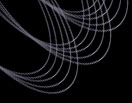
| SDSS Classic |
| SDSS.org |
| SDSS4.org |
| SDSS3.org |
| SDSS Data |
| DR19 |
| DR17 |
| DR10 |
| DR7 |
| Science |
| Press Releases |
| Education |
| Image Gallery |
| Legacy Survey |
| SEGUE |
| Supernova Survey |
| Collaboration |
| Publications |
| Contact Us |
| Search |

June 28, 2007
SDSS-II releases 10 terabytes of data to the public
One of the largest catalogs of the universe — a "road map of the sky" — was made public today by the Sloan Digital Sky Survey (SDSS-II), in the survey's sixth public data release (DR6).
With photometric and spectroscopic observations of the sky gathered during the last six years, this data release gives researchers and the public more than 10 terabytes of images and spectra in accessible online catalogs. The information can be found at www.sdss.org/dr6 for the scientific community and at http://skyserver.sdss.org for the general public.
DR6 includes images of roughly 287 million objects over 9,583 square degrees of the sky. The survey also includes 1.27 million spectra of stars, galaxies and quasars.
Among the recent discoveries are:
- the brightest known image of a gravitationally-lensed galaxy from the early universe. Astronomers said the light from this galaxy took more than 11 billion years to reach the telescope.
- 197 new, confirmed type 1a supernova, remnants of exploding stars in distant galaxies.
- seven — perhaps eight — new dwarf galaxies in our Local Group of galaxies, almost as many new Milky Way satellites as were detected in the previous 70 years.
"Many external researchers are already using the data from earlier public releases", explained Alex Szalay of the Johns Hopkins University, an architect of the SDSS data mining tools. In fact, researchers from outside of the consortium wrote more than half of the SDSS-related papers presented at recent American Astronomical Society meetings. "This is a clear indication that we've kept our promise to the scientific community of getting them uniformly high quality data in a timely manner and in a searchable format," Szalay said.
The SDSS-II is among the largest astronomical collaborations ever undertaken, with more than 300 astronomers, astrophysicists and engineers at 25 institutions around the world. Using a dedicated 2.5-meter telescope at Apache Point Observatory in southern New Mexico, astronomers are able to capture a record amount of data in five different wavelengths (from 3,000 to 10,000 Angstroms) using a 194-megapixel camera attached to the telescope.
The survey catalogs objects as faint as 22.5 magnitude, three million times fainter than the faintest star that can be seen with the naked eye on a dark night.
The SDSS recorded its first light in May 1998 and entered routine operations in April 2000. Data has been released yearly to the public since 2001.
The SDSS-II has three major components. The first, called LEGACY, completes the first SDSS survey of the extragalactic universe, obtaining images and distances of nearly a million galaxies and quasars over a continuous swath of sky in the Northern Hemisphere.
The second part is the Sloan Extension for Galactic Understanding and Exploration (SEGUE), mapping the structure and stellar makeup of the Milky Way Galaxy, and gathering data on how the Milky Way formed and evolved. It will unveil the ages, chemical compositions, and space distribution of stars — major clues to understanding how our own galaxy and others formed.
The new Sloan Supernova Survey is an intensive study of supernovae, sweeping the sky to find these remnants of gigantic explosions from dying stars. Finding these, astronomers can precisely measure the distances of distant supernovae, using them to map the rate of expansion of the universe.
With additional funding the National Science Foundation, the Alfred P. Sloan Foundation and institutional members, the survey will continue through 2008. A seventh data release (DR7) is scheduled for 2008 and the final release is schedule for late 2008.
Contacts:
- Michael Strauss, Princeton University, 609-258-3808, strauss@astro.princeton.edu
- David Weinberg, Scientific Spokesperson, Sloan Digital Sky Survey, 614-406-6243, dhw@astronomy.ohio-state.edu
- Gary S. Ruderman, Public Information Officer, Sloan Digital Sky Survey 312-320-4794, sdsspio@aol.com